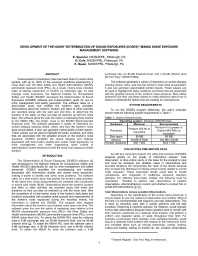Mining Publication: Development of the NIOSH Determination of Sound Exposures (DOSES) Mining Noise Exposure Management Software
Original creation date: January 2012
Overexposure to hazardous noise has been found in most mining sectors, with up to 100% of the surveyed workforce experiencing a noise dose that exceeds the U.S. Mine Safety and Health Administration (MSHA) permissible exposure level (PEL). As a result, miners show elevated rates of hearing impairment of 70-90% by retirement age. To help manage noise exposures, the U.S. National Institute for Occupational Safety and Health (NIOSH) developed the Determination of Sound Exposures (DOSES) software and implementation guide for use by mine management and safety personnel. This paper describes the development, functions and basic operation of the initial-release version of DOSES. A revised version is being developed to incorporate additional user-suggested functions, and its development and implementation to assess noise control solutions will be described in a future article. The software relies on a time-motion study that profiles the worker’s daily activities. Observations about the worker’s location and tasks or other activities are recorded along with the start and end time, to determine the duration of the tasks so they can later be matched up with the noise data. The software gives the user the option of assessing dose relative to the MSHA PEL, the action level or the NIOSH recommended exposure limit. The software generates a variety of interactive on-screen displays showing where, when and how the worker’s noise dose accumulated. It also can generate customizable printed reports. These outputs can be used to highlight the tasks, locations and times that are associated with the greatest amount of a worker’s noise exposure. DOSES simplifies and streamlines the record keeping and analysis associated with time-motion studies and worker noise exposures, so mine management can make engineering noise control or administrative control decisions to limit the noise overexposure of their workers.
Authors: ER Spencer, GP Cole, ER Bauer
Peer Reviewed Journal Article - January 2012
NIOSHTIC2 Number: 20040465
Trans Soc Min Metal Explor TP-10-023, 2012 Jan; 330:438-445
Conference Paper - February 2010
NIOSHTIC2 Number: 20036538
2010 SME Annual Meeting and Exhibit, February 28 - March 3, Phoenix, Arizona, preprint 10-081. Littleton, CO: Society for Mining, Metallurgy, and Exploration, Inc., 2010; :1-7
See Also
- Analysis of Nonstandard Noise Dosimeter Microphone Positions
- Assessment of Equipment Operator’s Noise Exposure in Western Underground Gold and Silver Mines
- Determination of Sound Exposures (DOSES): Software Manual and Implementation Guide
- DOSES - Determination of Sound Exposures - 1.1
- Drill Rig Incident
- Noise and Hearing Protection: Development of Two Training Exercises for Drillers
- Noise Exposure and Overhead Power Line (OPL) Safety Hazards at Surface Drilling Sites
- Technology News 536 - NIOSH Develops New Software to Analyze and Reduce Noise Exposure
- Technology News 538: Acoustic Enclosure to Reduce Noise From Vibrating Screen Mechanism Housings
- What Does a Hearing Loss Sound Like?
- Page last reviewed: 9/20/2012
- Page last updated: 9/25/2015
- Content source: National Institute for Occupational Safety and Health, Mining Program


 ShareCompartir
ShareCompartir
